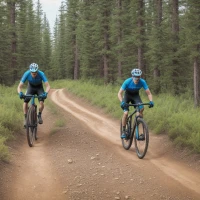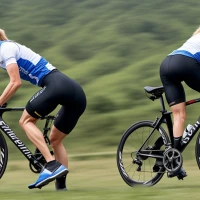The simple act of bicycling is more than just a way to travel or enjoy the outdoors; it’s a comprehensive workout that engages multiple muscle groups, pumping your fitness to new levels. As your feet push those pedals with rhythmic determination, there’s an entire network of muscles working harmoniously to propel you forward. Whether you’re a seasoned cyclist or just strapping on your first helmet, understanding the muscles biking works can enhance your riding performance and results. So, gear up, as we dive into the anatomy of cycling and discover how you can rev up your ride.
Bicycling isn’t just a leg workout – it’s a whole-body experience. From the lower extremities fueling each pedal stroke to the core stabilizing your body, a variety of muscle categories come into play. Knowing which muscles does biking work can help you tailor your training, avoid injury, and maximize the benefits of your cycling sessions.
The Engine Room: Lower Body Muscles Fired Up by Biking
Quadriceps: Your Pedal-Pushing Powerhouses
At the forefront of the cycling muscle squad are your quadriceps, which consist of four powerful muscles at the front of your thighs. These muscles are essential for the downstroke portion of pedaling—when you push down on the pedals, your quads are doing the heavy lifting.
- Vastus Lateralis
- Vastus Medialis
- Vastus Intermedius
- Rectus Femoris
Incorporating squats and lunges into your fitness routine can further strengthen your quads for an even more effective biking experience.
Hamstrings: The Upstroke Undertakers
While your quads get a hefty workout pushing down, your hamstrings take charge during the upstroke. Located at the back of your thighs, they work contrarily to your quads, pulling the pedal back up and preparing for the next stroke. This muscle group includes:
- Biceps Femoris
- Semitendinosus
- Semimembranosus
Regular hamstring stretches and exercises, such as deadlifts, can enhance their function for a smoother, more powerful ride.
Gluteal Muscles: The Cyclist’s Driving Force
When it comes to cycling, your gluteal muscles, including your gluteus maximus, medius, and minimus, are indispensable. These muscles provide significant force during the initial push-off and also help maintain proper pelvis alignment, which is crucial for efficient pedaling dynamics.
Stairs climbing and hip thrust exercises can specifically target and strengthen your glutes, contributing to a firmer, more powerful seat in the saddle.
Calves: Essential for Pedal Precision
Don’t underestimate the calves when considering what muscles does biking work. These muscles, particularly the gastrocnemius and soleus, are vital for the final push of the pedal stroke, pointing your toes downwards (plantar flexion) and giving that last bit of oomph. Strong calves not only add finesse to your pedaling but also assist with stability.
Calf raises and jump rope are excellent exercises to build stronger calves.
The Control Center: Core Muscles and Upper Body Engagement
Core Muscles: Stability and Endurance Experts
It may be less obvious, but your core muscles play a significant role in cycling. This central muscle group includes:
- Rectus Abdominis
- Obliques
- Transverse Abdominis
- Lower Back Muscles
They are indispensable for maintaining balance, proper posture, and transferring power efficiently throughout your body. A robust core will minimize unnecessary upper-body movement, thereby conserving energy and preventing fatigue.
To enhance your core strength, incorporate planks, crunches, and other stability exercises into your routine.
Upper Body Muscles: Auxiliary Yet Crucial
While cycling primarily targets the lower body, the upper body muscles shouldn’t be ignored. Your arm and shoulder muscles, particularly the biceps, triceps, deltoids, and pectorals, are engaged to steer, stabilize, and support on the handlebars, especially during intense rides or climbs.
Regular upper-body workouts with weights or resistance bands can develop these muscle groups, aiding in more comfortable and controlled rides.
Cycling’s Hidden Symphony: Secondary Muscles at Work
Hip Flexors: Tiny but Mighty
The hip flexors, particularly the iliopsoas, serve a notable purpose during cycling, aiding in the upward stroke of your pedal. Though small, they work persistently to maintain pedal fluidity and are worth conditioning with targeted exercises like leg raises.
The Foot’s Musculature: Fine-Tuning Pedal Interaction
While often overlooked, the intrinsic muscles of the foot also contribute to an efficient pedaling motion, aiding in stabilization and power distribution across the foot’s arch. Strengthening these muscles can be achieved with barefoot exercises and balance-focused activities.
Maximizing Cycling Muscles: Tips and Tricks
Strength Training: A Cyclist’s Best Ally
To make the most of your cycling efforts, incorporating strength training that focuses on the key muscle groups used in cycling can pay huge dividends. This cross-training approach helps mitigate muscular imbalances and boosts overall strength and endurance.
Stretching: Flexibility for Functionality
Endurance athletes, especially cyclists, struggle with tightness in specific muscle groups. Thus, regular stretching is essential, not merely for flexibility but also for preventing strains and improving muscle recovery. Focus on quads, hamstrings, hip flexors, and calves for a well-rounded routine.
Nutrition and Recovery: Fueling the Inner Fire
Optimal nutrition and adequate recovery time are paramount to ensure that the muscles biking works are ready for the next challenge. Protein intake, hydration, and rest are the trifecta of muscle repair and growth. Incorporate these into your regimen to support sustained improvement and health.
Riding Strategies: Leveraging Your Muscle Power
Cadence Considerations: The Sweet Spot of Speed and Strength
Finding the right cadence, or pedal revolutions per minute, can make a significant impact on muscle workload. A higher cadence with lower resistance tends to place less strain on the muscles, while a lower cadence with higher resistance will require more force per stroke, recruiting different muscle fibers.
Climbing and Sprinting: Muscle Engagement Variants
When your ride moves uphill, your body position shifts, and different muscle groups are activated more intensely—primarily the glutes and hamstrings. In contrast, when sprinting, you’ll engage more of your quads and core to generate quick bursts of power.
Long Distance Endurance: Muscular Stamina Building
Long-distance rides are an excellent way to build muscular endurance. Over time, your body adapts to sustain a consistent output of power for extended periods. This endurance component not only strengthens muscles but also improves cardiovascular health.
Cycling is a dynamic sport and fitness activity that activates a variety of muscle groups, from the prominent lower body muscles like quadriceps, hamstrings, and gluteal muscles, to often overlooked areas such as core stability muscles, upper body muscles, and even the feet’s musculature.
By understanding what muscles biking works and implementing targeted strength training, stretching, proper nutrition, and strategic cycling practices, you can rev up your rides, maximize your performance, and sculpt a stronger, more resilient body prepared for any cycling challenge.
Whether you’re cycling for pleasure, commuting, or competition, embracing the full spectrum of muscles involved in biking will not only enhance your ride—it will transform your entire fitness journey. Now that you’re equipped with this knowledge, clip in, pedal with power, and watch as every cycle takes you closer to your fitness aspirations. The road ahead is yours to conquer, with every muscle group fueling your journey.










